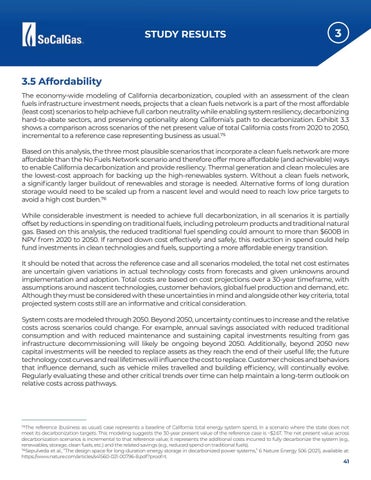STUDY RESULTS
3
3.5 Affordability The economy-wide modeling of California decarbonization, coupled with an assessment of the clean fuels infrastructure investment needs, projects that a clean fuels network is a part of the most affordable (least cost) scenarios to help achieve full carbon neutrality while enabling system resiliency, decarbonizing hard-to-abate sectors, and preserving optionality along California’s path to decarbonization. Exhibit 3.3 shows a comparison across scenarios of the net present value of total California costs from 2020 to 2050, incremental to a reference case representing business as usual.75 Based on this analysis, the three most plausible scenarios that incorporate a clean fuels network are more affordable than the No Fuels Network scenario and therefore offer more affordable (and achievable) ways to enable California decarbonization and provide resiliency. Thermal generation and clean molecules are the lowest-cost approach for backing up the high-renewables system. Without a clean fuels network, a significantly larger buildout of renewables and storage is needed. Alternative forms of long duration storage would need to be scaled up from a nascent level and would need to reach low price targets to avoid a high cost burden.76 While considerable investment is needed to achieve full decarbonization, in all scenarios it is partially offset by reductions in spending on traditional fuels, including petroleum products and traditional natural gas. Based on this analysis, the reduced traditional fuel spending could amount to more than $600B in NPV from 2020 to 2050. If ramped down cost effectively and safely, this reduction in spend could help fund investments in clean technologies and fuels, supporting a more affordable energy transition. It should be noted that across the reference case and all scenarios modeled, the total net cost estimates are uncertain given variations in actual technology costs from forecasts and given unknowns around implementation and adoption. Total costs are based on cost projections over a 30-year timeframe, with assumptions around nascent technologies, customer behaviors, global fuel production and demand, etc. Although they must be considered with these uncertainties in mind and alongside other key criteria, total projected system costs still are an informative and critical consideration. System costs are modeled through 2050. Beyond 2050, uncertainty continues to increase and the relative costs across scenarios could change. For example, annual savings associated with reduced traditional consumption and with reduced maintenance and sustaining capital investments resulting from gas infrastructure decommissioning will likely be ongoing beyond 2050. Additionally, beyond 2050 new capital investments will be needed to replace assets as they reach the end of their useful life; the future technology cost curves and real lifetimes will influence the cost to replace. Customer choices and behaviors that influence demand, such as vehicle miles travelled and building efficiency, will continually evolve. Regularly evaluating these and other critical trends over time can help maintain a long-term outlook on relative costs across pathways.
75The reference (business as usual) case represents a baseline of California total energy system spend, in a scenario where the state does not meet its decarbonization targets. This modeling suggests the 30-year present value of the reference case is ~$2.6T. The net present value across decarbonization scenarios is incremental to that reference value; it represents the additional costs incurred to fully decarbonize the system (e.g., renewables, storage, clean fuels, etc.) and the related savings (e.g., reduced spend on traditional fuels). 76Sepulveda et al., “The design space for long-duration energy storage in decarbonized power systems,” 6 Nature Energy 506 (2021), available at: https://www.nature.com/articles/s41560-021-00796-8.pdf?proof=t.
41
